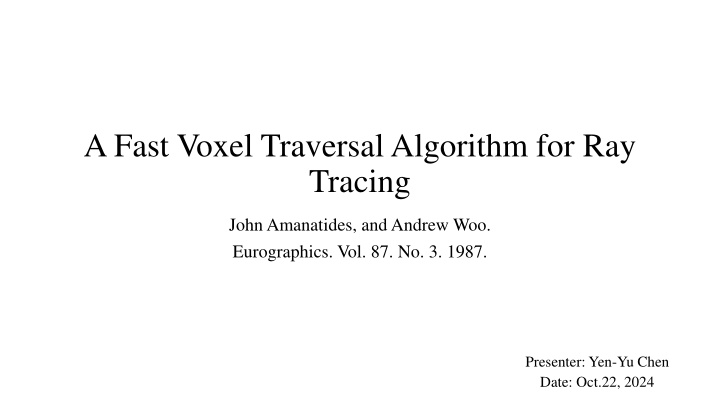
Fast Voxel Traversal Algorithm for Ray Tracing: A Comprehensive Overview
Learn about the efficient voxel traversal algorithm for ray tracing introduced by Amanatides and Woo in 1987. This algorithm simplifies 3D space partitioning with minimal floating-point computations, reducing the number of ray-object intersections. Explore strategies like hierarchical bounding volumes and space partitioning, along with constant size voxel partitioning techniques. Dive into the implementation details and step-by-step process of the algorithm through visual representations.
Download Presentation

Please find below an Image/Link to download the presentation.
The content on the website is provided AS IS for your information and personal use only. It may not be sold, licensed, or shared on other websites without obtaining consent from the author. If you encounter any issues during the download, it is possible that the publisher has removed the file from their server.
You are allowed to download the files provided on this website for personal or commercial use, subject to the condition that they are used lawfully. All files are the property of their respective owners.
The content on the website is provided AS IS for your information and personal use only. It may not be sold, licensed, or shared on other websites without obtaining consent from the author.
E N D
Presentation Transcript
A Fast Voxel Traversal Algorithm for Ray Tracing John Amanatides, and Andrew Woo. Eurographics. Vol. 87. No. 3. 1987. Presenter: Yen-Yu Chen Date: Oct.22, 2024
Abstract A fast and simple voxel traversal algorithm through a 3D space partition is introduced. Going from one voxel to its neighbour requires only two floating point comparisons and one floating point addition. Also, multiple ray intersections with objects that are in more than one voxel are eliminated. 2
Strategies for Intersection Culling 1. hierarchical bounding volumes 2. space partitioning
Space Partitioning 1. octrees by Glassner 2. constant size voxel partitioning
Ray Tracing on Constant Size Voxel Partitioning
Algorithm tMaxX: voxel tMaxY: voxel tDeltaX = voxelX ( ?) tDeltaY = voxelY ( ?) ? ? ? (0,0)
Algorithm Initial tMaxX: 1t tMaxY: 2.9t tDeltaX = 1.5t tDeltaY = 2.1t ? ? tMaxX < tMaxY voxel(0,0) tMaxX = tMaxX+tDeltaX = 2.5t ? (0,0)
Algorithm tMaxX: 2.5t tMaxY: 2.9t tDeltaX = 1.5t tDeltaY = 2.1t ? ? tMaxX < tMaxY tMaxX = tMaxX+tDeltaX = 4.0t ? (0,0) (1,0)
Algorithm tMaxX: 4.0t tMaxY: 2.9t tDeltaX = 1.5t tDeltaY = 2.1t ? ? tMaxY < tMaxX tMaxY = tMaxY+tDeltaY = 5.0t ? (1,1) (1,0) (0,0)
Algorithm tMaxX: 4.0t tMaxY: 5.0t tDeltaX = 1.5t tDeltaY = 2.1t ? ? tMaxX < tMaxY tMaxX = tMaxX+tDeltaX = 5.5t ? (1,1) (1,0) (2,1) (0,0)
